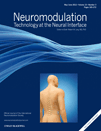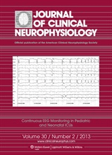
NEUROMODULATION
Scope & Guideline
Bridging Clinical Practice and Scientific Discovery
Introduction
Aims and Scopes
- Spinal Cord Stimulation (SCS) Techniques:
Focuses on the mechanisms, advancements, and clinical outcomes related to spinal cord stimulation as a treatment for chronic pain, emphasizing novel waveforms and stimulation paradigms. - Dorsal Root Ganglion Stimulation (DRGS):
Investigates the use of dorsal root ganglion stimulation for chronic pain management, exploring its efficacy, safety, and comparison with other neuromodulation techniques. - Peripheral Nerve Stimulation (PNS):
Covers various applications of peripheral nerve stimulation for pain relief and functional restoration in patients with chronic conditions. - Transcranial Magnetic Stimulation (TMS) and Transcranial Direct Current Stimulation (tDCS):
Examines the application of non-invasive brain stimulation methods for neurological and psychiatric conditions, highlighting mechanisms, outcomes, and patient response. - Neurophysiological Mechanisms and Biomarkers:
Research on the underlying neurophysiological mechanisms of neuromodulation therapies, including biomarker identification and their implications for treatment outcomes. - Clinical Outcomes and Patient-Centered Approaches:
Focuses on assessing the clinical effectiveness of neuromodulation therapies, patient-reported outcomes, and quality of life improvements. - Innovative Techniques and Technologies:
Explores cutting-edge technologies and methodologies in neuromodulation, including closed-loop systems and wearable devices for personalized treatment.
Trending and Emerging
- Novel Stimulation Waveforms and Paradigms:
Recent studies are increasingly focused on innovative stimulation waveforms, such as burst and high-frequency stimulation, which show promise in enhancing pain relief and minimizing side effects. - Closed-Loop Systems and Real-Time Monitoring:
The emergence of closed-loop neuromodulation systems that adapt stimulation parameters based on real-time feedback from patients is gaining attention, indicating a shift towards personalized medicine. - Multimodal Neuromodulation Approaches:
There is a growing trend towards combining different neuromodulation techniques, such as peripheral nerve stimulation with spinal cord stimulation, to achieve better clinical outcomes. - Focus on Quality of Life and Patient-Centered Outcomes:
Research is increasingly emphasizing the impact of neuromodulation therapies on quality of life, patient satisfaction, and long-term functional outcomes. - Application in Diverse Populations and Conditions:
Emerging studies are exploring the use of neuromodulation therapies in diverse patient populations, including pediatric patients and those with complex comorbidities. - Integration of Digital Health Technologies:
The incorporation of digital health solutions, such as telemedicine and remote monitoring for neuromodulation therapies, is becoming more prevalent in recent publications.
Declining or Waning
- Traditional SCS Techniques:
There is a noticeable decrease in publications focusing solely on traditional spinal cord stimulation techniques without innovative adaptations, as research shifts toward more advanced modalities. - Invasive Techniques for Pain Management:
The focus on invasive techniques for chronic pain management is waning, with a shift towards exploring non-invasive alternatives and combination therapies. - Basic Research in Animal Models:
While foundational animal studies remain important, there is a trend towards prioritizing clinical and translational research over basic science studies. - Generalized Neuromodulation Applications:
Research that broadly covers neuromodulation without specific focus on clinical applications or targeted populations is less frequently published, indicating a trend towards more specialized studies. - Historical Reviews and Background Studies:
There is a decrease in the publication of historical reviews or background studies that do not provide novel insights or advancements in the field.
Similar Journals

JOURNAL OF ECT
Shaping the Future of Psychiatry and NeuroscienceJOURNAL OF ECT, a reputable publication under the esteemed Lippincott Williams & Wilkins, serves as a vital resource for scholars and practitioners in the fields of medicine, psychiatry, and neuroscience. With an ISSN of 1095-0680 and an E-ISSN of 1533-4112, this journal is dedicated to advancing knowledge in electroconvulsive therapy and related neuropsychiatric interventions. Instrumental in fostering interdisciplinary dialogue, it maintains a commendable impact factor that places it in the Q2 category for both Medicine and Psychiatry & Mental Health, and Q3 for Neuroscience based on the latest rankings. Spanning a rich history from 1998 to 2024, the journal not only disseminates groundbreaking research but also emphasizes clinical applications and ongoing developments in the mental health sphere. Access options are available for readers seeking to deepen their understanding of treatment modalities that continue to evolve in practice. This makes the JOURNAL OF ECT an essential read for researchers, mental health professionals, and students aiming to stay abreast of the latest trends and insights in this dynamic field.

DEPRESSION AND ANXIETY
Transforming knowledge into impactful mental health solutions.DEPRESSION AND ANXIETY is a leading academic journal published by WILEY, dedicated to presenting cutting-edge research in the fields of clinical psychology, psychiatry, and mental health. With an impressive impact factor underscoring its prominence—ranked in the top quartile (Q1) for both clinical psychology and psychiatry, and occupying the 7th and 20th ranks in Scopus respectively—this journal serves as a pivotal resource for researchers, professionals, and students alike. Since its inception in 1996 and continuing through 2024, DEPRESSION AND ANXIETY has been at the forefront of disseminating findings that significantly impact our understanding of mental health issues. The journal's rigorous peer-review process ensures the highest quality of published works, making it an essential platform for scholars aiming to advance knowledge and contribute meaningfully to the mental health discourse.

Agri-The Journal of the Turkish Society of Algology
Transforming Pain Management Strategies for a Global AudienceAgri - The Journal of the Turkish Society of Algology, published by KARE PUBL, is a significant academic platform dedicated to advancing the field of anesthesiology and pain medicine. Established in 1993, this journal has made substantial contributions towards understanding pain management strategies and therapeutic interventions in the medical community in Turkey and beyond. With an impact factor reflecting its Q3 category ranking within Anesthesiology and Pain Medicine and a respectable Scopus rank of 93 out of 136, it provides critical insights and research findings that are instrumental for both clinicians and researchers alike. The journal operates under an open access model, which enhances the visibility and accessibility of valuable research outputs for a global audience. An essential resource for professionals in pain management, Agri encourages the exchange of innovative ideas and groundbreaking studies within this vital area of medicine.

SOMATOSENSORY AND MOTOR RESEARCH
Advancing Understanding in Sensory and Motor DynamicsSOMATOSENSORY AND MOTOR RESEARCH is a distinguished journal dedicated to exploring the intricate relationship between sensory and motor systems. Published by Taylor & Francis Ltd, this journal has been a significant resource for researchers in the fields of neuroscience and physiology since its inception in 1983, until it converged its coverage in 2017. Although it is no longer indexed in Scopus, SOMATOSENSORY AND MOTOR RESEARCH continues to contribute valuable insights into sensory systems and physiology, evidenced by its rankings in the lower percentiles of its respective categories. With a strong focus on empirical research, the journal aims to facilitate the dissemination of innovative studies that impact both academic understanding and clinical practices. Potential authors and researchers can access the journal's collection of past articles to further their knowledge and foster collaboration in this niche yet vital area of study. Its legacy endures as an informative platform for academics looking to bridge the gap between theoretical and applied sciences in the realm of somatosensory and motor functions.

JOURNAL OF MUSCULOSKELETAL & NEURONAL INTERACTIONS
Connecting Musculoskeletal and Neuronal Insights for Better HealthJOURNAL OF MUSCULOSKELETAL & NEURONAL INTERACTIONS, published by JMNI in Greece, serves as a vital platform for disseminating cutting-edge research in the fields of musculoskeletal and neuronal sciences. Established in 2002, this journal has continued to evolve, presenting studies that bridge the critical interactions between musculoskeletal health and neuronal function. With a current impact factor reflected in its rankings, it holds a Q3 classification in Endocrinology, Diabetes and Metabolism, and a Q2 classification in Orthopedics and Sports Medicine, alongside Q3 in Physiology, placing it prominently within the academic landscape. The journal's accessibility, while not officially labeled as Open Access, ensures that valuable research findings are available to an international audience of researchers, professionals, and students committed to advancing the understanding of human health. The depth and breadth of content in the JOURNAL OF MUSCULOSKELETAL & NEURONAL INTERACTIONS underscore its importance in fostering innovation and collaboration across related disciplines, making it a must-read for those invested in the future of musculoskeletal and neuronal research.

JOURNAL OF COGNITIVE NEUROSCIENCE
Pioneering insights into cognitive processes.Welcome to the JOURNAL OF COGNITIVE NEUROSCIENCE, a premier publication in the field of cognitive neuroscience, published by the esteemed MIT PRESS. Since its inception in 1989, this journal has been at the forefront of advancing our understanding of the neural mechanisms underlying cognitive processes, boasting an impressive convergence period through 2024. With its Q1 ranking in the 2023 cognitive neuroscience category, it stands out among 115 peers, indicating its critical role in shaping contemporary research. The journal offers a comprehensive array of research articles, reviews, and methodologies aimed at researchers, professionals, and students alike, facilitating the exploration of complex cognitive functions. While not an open-access journal, it provides essential insights and significant contributions to the neuroscience community, making it an invaluable resource for anyone keen on delving into the intricacies of the human brain.

IEEE Magnetics Letters
Exploring the Frontiers of Magnetics InnovationIEEE Magnetics Letters, published by IEEE-INST ELECTRICAL ELECTRONICS ENGINEERS INC, is a leading journal focusing on the rapidly evolving field of magnetics, encompassing electronics, optics, and magnetic materials. With an ISSN of 1949-307X and an E-ISSN of 1949-3088, this journal serves as a premier platform for researchers to disseminate innovative findings, discussions, and reviews from 2010 to 2024. Recognized for its contribution to the field, it is classified in the third quartile (Q3) of Electronic, Optical and Magnetic Materials, and it holds a respectable place in Scopus rankings, positioned #189/284 in its category. Although it operates under traditional access options, the journal remains vital for professionals and academics seeking to deepen their understanding of magnetics and its applications in modern technology. With its commitment to advancing knowledge and fostering innovation, IEEE Magnetics Letters continues to be an invaluable resource for those engaged in cutting-edge research.

Tremor and Other Hyperkinetic Movements
Exploring the complexities of movement disorders with open access.Tremor and Other Hyperkinetic Movements is a pioneering open-access journal published by UBIQUITY PRESS LTD, dedicated to advancing the understanding of hyperkinetic movement disorders, including tremors. Since its inception in 2011, the journal has provided a vital platform for researchers, professionals, and students within the fields of neurology and movement disorders to share innovative findings, case studies, and clinical trials. With its contributions spanning from 2012 to 2024, the journal emphasizes high-quality research and fosters collaboration within the medical community. Although it holds a Scopus rank of 156 in the field of Medicine, particularly Cardiology and Cardiovascular Medicine, its value extends beyond metrics, inviting interdisciplinary dialogue about the mechanisms, treatments, and implications of these complex disorders. By offering unrestricted access to its content, Tremor and Other Hyperkinetic Movements ensures that crucial knowledge reaches a global audience, thus enabling advancements in clinical practices and improved patient outcomes.

JOURNAL OF CLINICAL NEUROPHYSIOLOGY
Pioneering Discoveries in the Realm of NeurophysiologyJOURNAL OF CLINICAL NEUROPHYSIOLOGY, an esteemed publication under Lippincott Williams & Wilkins, has been at the forefront of disseminating cutting-edge research and clinical advancements since its inception in 1984. With an ISSN of 0736-0258 and an E-ISSN of 1537-1603, this journal serves as a vital resource for professionals and researchers in the fields of medicine, neurology, and physiology, consistently maintaining its prestigious Q2 ranking in various categories as of 2023. It holds a significant position in Scopus rankings, particularly in Clinical Neurology and Physiology, providing insights that are essential for clinicians, neurologists, and scholars alike. Although it does not currently offer open access, it remains a crucial platform for advancing knowledge and practice in clinical neurophysiology. The journal not only aims to foster a deeper understanding of neurophysiological methods and their clinical applications but also encourages innovative research that addresses current challenges in the field. By bridging theory and practice, the JOURNAL OF CLINICAL NEUROPHYSIOLOGY plays an indispensable role in enhancing the quality of patient care and advancing the science of neurology.

RESTORATIVE NEUROLOGY AND NEUROSCIENCE
Unraveling Neural Mysteries: Your Gateway to Restorative AdvancesRESTORATIVE NEUROLOGY AND NEUROSCIENCE, published by IOS PRESS, is a premier journal dedicated to advancing the fields of neurology and neuroscience. Since its inception in 1989, this journal has played a crucial role in disseminating cutting-edge research findings and innovative therapeutic approaches that aim to restore neurological function and improve patient outcomes. With a focus on developmental neuroscience and clinical neurology, the journal holds a 2023 Scopus ranking of #129 out of 400 in clinical neurology, and #15 out of 37 in developmental neuroscience, reflecting its significant influence in these domains. Although it operates on a non-open access model, RESTORATIVE NEUROLOGY AND NEUROSCIENCE offers valuable insights for researchers, healthcare professionals, and students seeking to deepen their understanding of neural restoration mechanisms and therapeutic strategies. Located in Amsterdam, Netherlands, the journal continues to foster scholarly dialogue and innovation, contributing to the global advancement of neuroscience and neurology.